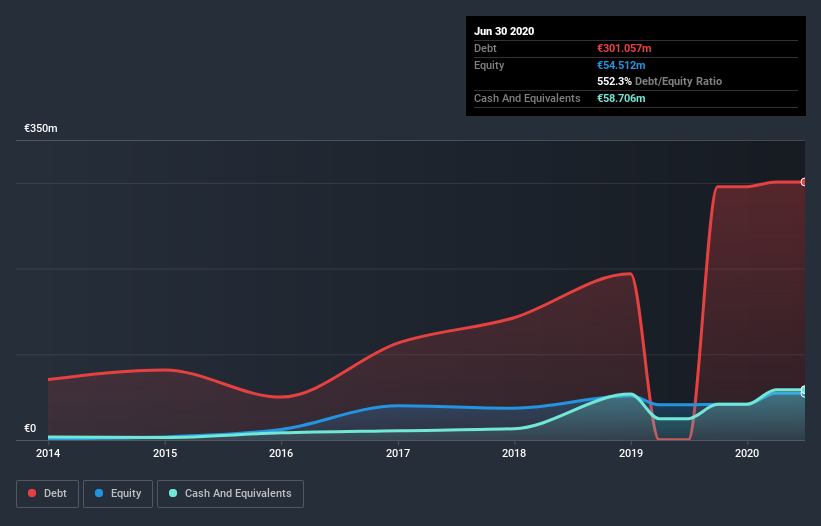David Iben put it well when he said, 'Volatility is not a risk we care about. What we care about is avoiding the permanent loss of capital.' It's only natural to consider a company's balance sheet when you examine how risky it is, since debt is often involved when a business collapses. As with many other companies GIEAG Immobilien AG (MUN:2GI) makes use of debt. But should shareholders be worried about its use of debt?
When Is Debt Dangerous?
Generally speaking, debt only becomes a real problem when a company can't easily pay it off, either by raising capital or with its own cash flow. In the worst case scenario, a company can go bankrupt if it cannot pay its creditors. However, a more common (but still painful) scenario is that it has to raise new equity capital at a low price, thus permanently diluting shareholders. By replacing dilution, though, debt can be an extremely good tool for businesses that need capital to invest in growth at high rates of return. The first thing to do when considering how much debt a business uses is to look at its cash and debt together.
View our latest analysis for GIEAG Immobilien
How Much Debt Does GIEAG Immobilien Carry?
The image below, which you can click on for greater detail, shows that at June 2020 GIEAG Immobilien had debt of €301.1m, up from €169.2k in one year. However, it also had €58.7m in cash, and so its net debt is €242.4m.

How Strong Is GIEAG Immobilien's Balance Sheet?
The latest balance sheet data shows that GIEAG Immobilien had liabilities of €257.4m due within a year, and liabilities of €125.4m falling due after that. Offsetting these obligations, it had cash of €58.7m as well as receivables valued at €1.27m due within 12 months. So its liabilities outweigh the sum of its cash and (near-term) receivables by €322.8m.
This deficit casts a shadow over the €71.8m company, like a colossus towering over mere mortals. So we'd watch its balance sheet closely, without a doubt. After all, GIEAG Immobilien would likely require a major re-capitalisation if it had to pay its creditors today.
We measure a company's debt load relative to its earnings power by looking at its net debt divided by its earnings before interest, tax, depreciation, and amortization (EBITDA) and by calculating how easily its earnings before interest and tax (EBIT) cover its interest expense (interest cover). This way, we consider both the absolute quantum of the debt, as well as the interest rates paid on it.
Weak interest cover of 1.9 times and a disturbingly high net debt to EBITDA ratio of 10.4 hit our confidence in GIEAG Immobilien like a one-two punch to the gut. The debt burden here is substantial. One redeeming factor for GIEAG Immobilien is that it turned last year's EBIT loss into a gain of €21m, over the last twelve months. When analysing debt levels, the balance sheet is the obvious place to start. But it is GIEAG Immobilien's earnings that will influence how the balance sheet holds up in the future. So when considering debt, it's definitely worth looking at the earnings trend. Click here for an interactive snapshot.
Finally, a business needs free cash flow to pay off debt; accounting profits just don't cut it. So it's worth checking how much of the earnings before interest and tax (EBIT) is backed by free cash flow. Considering the last year, GIEAG Immobilien actually recorded a cash outflow, overall. Debt is usually more expensive, and almost always more risky in the hands of a company with negative free cash flow. Shareholders ought to hope for an improvement.
Our View
To be frank both GIEAG Immobilien's net debt to EBITDA and its track record of staying on top of its total liabilities make us rather uncomfortable with its debt levels. Having said that, its ability to grow its EBIT isn't such a worry. Taking into account all the aforementioned factors, it looks like GIEAG Immobilien has too much debt. While some investors love that sort of risky play, it's certainly not our cup of tea. There's no doubt that we learn most about debt from the balance sheet. However, not all investment risk resides within the balance sheet - far from it. For example, we've discovered 4 warning signs for GIEAG Immobilien (1 shouldn't be ignored!) that you should be aware of before investing here.
If, after all that, you're more interested in a fast growing company with a rock-solid balance sheet, then check out our list of net cash growth stocks without delay.
If you decide to trade GIEAG Immobilien, use the lowest-cost* platform that is rated #1 Overall by Barron’s, Interactive Brokers. Trade stocks, options, futures, forex, bonds and funds on 135 markets, all from a single integrated account. Promoted
New: Manage All Your Stock Portfolios in One Place
We've created the ultimate portfolio companion for stock investors, and it's free.
• Connect an unlimited number of Portfolios and see your total in one currency
• Be alerted to new Warning Signs or Risks via email or mobile
• Track the Fair Value of your stocks
This article by Simply Wall St is general in nature. It does not constitute a recommendation to buy or sell any stock, and does not take account of your objectives, or your financial situation. We aim to bring you long-term focused analysis driven by fundamental data. Note that our analysis may not factor in the latest price-sensitive company announcements or qualitative material. Simply Wall St has no position in any stocks mentioned.
*Interactive Brokers Rated Lowest Cost Broker by StockBrokers.com Annual Online Review 2020
Have feedback on this article? Concerned about the content? Get in touch with us directly. Alternatively, email editorial-team@simplywallst.com.
About MUN:2GI
GIEAG Immobilien
Develops commercial and residential properties in southern Germany.
Acceptable track record with mediocre balance sheet.
Market Insights
Community Narratives



